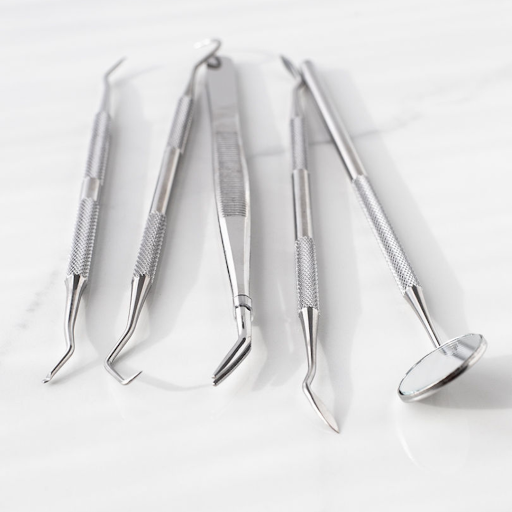

We’ve established that many people struggle with dental anxiety, but we find that a great way to dispel fear around something is to educate ourselves and learn more about things we tend to avoid. A study found that fear of dental instruments is one of the main reasons patients suffer from this anxiety and avoid dental appointments. While these instruments can look intimidating or even make unpleasant sounds, they also help dentists clean teeth, diagnose issues with teeth, or repair damage to teeth.
We’ve created a list of the most common dental tools in order to clear up some of the stigmas around these devices.
- Mouth Mirror
Mouth mirrors are likely the least intimidating dental tool on this list, but arguably one of the most important. They allow the dentist or dental hygienist to see the hard-to-reach areas of your mouth in order to check for issues or signs of decay. They also allow for the ability to easily move a tongue or mouth tissue around instead of having to use hands to do so.
- Sickle Probe
Also known as a dental explorer, a sickle probe can come in several different forms, but they are all a metal stick with different-shaped hooks on the end. While this sharp object may look scary, its main purpose is to check the surface of your teeth for any soft spots that may indicate a cavity or tartar build-up in a periodontal pocket. They can also be used to scrape away plaque from between teeth and off the surface of teeth. This handy tool helps prevent cavities from forming and helps discover early signs of decay.
- Scaler
Dental scalers are a surgical tool that dentists use to remove excessive and hardened tartar build-up on the teeth, also called calculus. It goes further than a sickle probe to scrape out significant build up, and prevents tooth loss due to decay from excess tartar and plaque.
- Suction Device
While this device may sound loud, it’s nothing to be alarmed about. In fact, this long tube connected to a vacuum is often one of the more enjoyable parts of a dental visit, and can be the source of some comic relief with the funny noises it makes. This suction device sucks up excess saliva and debris during your visit, and allows the dentists to have a dry area to work with.
- Dental Drill
The dental drill is often the source of most people’s dental anxiety. The high-pitched squeal of the drill often puts knots in people’s stomachs, but it’s a helpful and necessary tool that does a lot of good in the dental field. A dental drill is used to remove dental decay before a filling, to smooth a tooth’s surface, or to reshape a dental restoration. It’s designed to have a stream of water coming out while cutting into teeth to prevent the drill from becoming too hot and causing damage to the tooth. While the vibrations may feel somewhat uncomfortable, you shouldn’t experience any pain with a drill after being administered local anesthetic.
- Dental Retractor
A dental retractor is a tool used to hold open parts of the mouth for a dental exam, procedure or surgery. They are useful so patients don’t have to strain themselves trying to hold their mouths open wide for an extended amount of time.
- Molds
Dental molds are two trays filled with a liquid for you to bite down into, and once it hardens, you have a perfect impression of your teeth that can be used to identify problem areas, or to create crowns, caps, mouth guards, braces, retainers, etc.
Dental tools are really very fascinating once you learn more about them. One important note is that you should never attempt to use dental tools at home by yourself. Dentists and dental technicians undergo a lot of training to ensure they use these tools correctly, and trying them out on your own could result in more damage to your teeth. We hope that learning about these tools has served to relieve some dental anxiety, and we would love for you to set up an appointment with us at Simply Smiles so we can answer any of your questions about the tools we use on a daily basis to serve you and your smile.
Sources:
https://www.dentaly.org/us/oral-health/dental-tools/
https://www.cattanicompressors.com.au/2021/12/28/dental-equipment-names/
https://www.dental-engineers.co.uk/beginners-guide-dental-instruments/
https://www.portmandentalcare.com/dental-articles/what-equipment-does-your-dentist-use
https://www.123dentist.com/a-brief-guide-on-dental-tools/
https://www.kimballandbeecher.com/articles/general/understanding-common-dental-tools/
